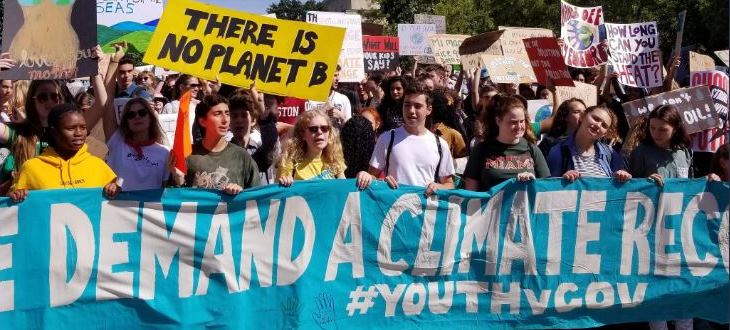The State We're In
Global youth demand climate action
The signs said it all: “There’s no Planet B.” “The world is changing, why aren’t we?” “Our home is on fire.” “I would be in school if the planet was more cool.”
Last Friday, Sept. 20, millions of young people all over the world skipped school to demand action on climate change.
School strikes were held in many New Jersey towns, including New Brunswick, Montclair, Morristown, Princeton, Red Bank, Lambertville, Maplewood, Englewood, Highland Park and Belvidere. Many more New Jersey students traveled to New York City and Philadelphia to join larger crowds.
The strikes – held three days before the United Nations Climate Action Summit in New York – are believed to be the largest-ever global youth protest over political inaction on climate change.
The catalyst for the climate strikes is 16-year-old Swedish activist Greta Thunberg, founder of the “Friday for Future” movement, which is calling on youth around the world to take action in their communities.
In August 2018, Greta began refusing to attend school after learning that Sweden had experienced its hottest summer in 262 years of record-keeping. Instead, she spent her days demonstrating in front of Sweden’s parliament in Stockholm to raise awareness about climate change. She was inspired by the high school students in Parkland, Florida, who boycotted classes after 17 people were killed in a 2018 shooting.
Greta’s call to action has since been embraced by younger generations around the world who have the most to lose from climate change.
And her voice has turned into a roar. Addressing the U.N. Climate Action Summit, the teen fiercely criticized the political powers that be.
“This is all wrong,” said Greta. “I shouldn’t be standing here. I should be back in school on the other side of the ocean. Yet you all come to me for hope? How dare you! You have stolen my dreams and my childhood with your empty words. And yet I’m one of the lucky ones. People are suffering. People are dying. Entire ecosystems are collapsing. We are in the beginning of a mass extinction. And all you can talk about is money and fairy tales of eternal economic growth.”
Greta is not alone. Recent research indicates that young females are emerging as the world’s new environmental leaders. In a survey of more than 100 U.S. organizers of the climate strike and nearly 200 participants in the Washington, D.C. protest, University of Maryland sociologist Dana Fisher found that 68 percent of organizers and 58 percent of participants were female.
We should all pay attention. Climate change is already bringing rising sea levels, warmer temperatures and more extreme weather events like floods, droughts, hurricanes and wildfires. Scientists warn that the worst impacts are coming sooner than expected.
A new report by the banking and investment firm Goldman Sachs warned of “significant” potential risks to the world’s largest cities, which are especially vulnerable to rising seas and storm surges.
The report predicted potential food shortages: “Warmer temperatures and shifting precipitation patterns could reduce yields and nutritional quality, as well change growing seasons and agricultural zones around the world.”
Drinking water availability and quality would also be affected. “Half of the world’s population will live in water-stressed areas as soon as 2025,” said the Goldman Sachs report, citing the World Health Organization.
Dire predictions in this and a multitude of other reports have young people feeling frightened and angry. What kind of world will they inherit? How will they and their children survive on a hotter and less hospitable planet? Why hasn’t the older generation done more to stop the crisis?
It won’t be long before the youngest of the climate protestors grow up to make their own choices, including voting for candidates who listen to them.
As Greta Thunberg put it, “We deserve a safe future, and we demand a safe future. Is that too much to ask?”
To learn more about Greta and Friday for Future, go to www.fridaysforfuture.org/.
To read the Goldman Sachs report, go to www.goldmansachs.com/citizenship/environmental-stewardship/market-solutions-to-address-climate-change/.
To read the latest United Nations climate change reports, go to www.un.org/en/climatechange/reports.shtml.
And to learn more about preserving New Jersey’s land and natural resources – which help reduce carbon in the atmosphere – visit the New Jersey Conservation Foundation website at www.njconservation.org or contact me at info@njconservation.org.
About the Authors
Alison Mitchell
Co-Executive Director
John S. Watson, Jr.
Co-Executive Director
Tom Gilbert
Co-Executive Director, 2022-2023
Michele S. Byers
Executive Director, 1999-2021
View their full bios here.
Filter
Get The Latest News
From The Garden State
In the
News

